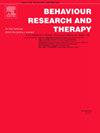使用网络分析表征认知加工治疗期间的临床改善。
IF 4.2
2区 心理学
Q1 PSYCHOLOGY, CLINICAL
引用次数: 0
摘要
目的:横断面网络研究发现关于网络结构变化作为跨障碍治疗反应的混合结果。本研究从网络心理测量学的角度描述了认知加工治疗(CPT)对退伍军人创伤后应激障碍心理健康的改善,并探讨了横截面网络如何帮助我们理解创伤后应激障碍的恢复。方法:PTSD退伍军人参加基于cpt的强化治疗方案(ITPs),分为两周(N = 635)和三周(N = 457)两种形式。在治疗前、治疗中和治疗后,PTSD症状在DSM-5 (PCL-5)的PTSD检查表上自我报告。使用网络比较测试对每个时间点的横断面网络进行比较。线性回归测试了从入院到治疗中期的初始治疗收益与总体结果的关系是否与节点的预期影响中心性相关。结果:PTSD症状明显改善,但网络结构基本未受影响,整体边缘强度从治疗前到治疗后均有所增加。具有高预期影响的淋巴结的初始治疗收益与总体治疗结果相关。基于共因模型的事后模拟产生了类似的回归结果,表明尽管我们的发现与扩散激活一致,但它们并不专属于这种机制。结论:治疗前和治疗后横断面网络的不可区分性提出了横断面网络是否能在传统治疗反应测量之外阐明PTSD恢复的问题。本文章由计算机程序翻译,如有差异,请以英文原文为准。
Using network analysis to characterize clinical improvement during cognitive processing therapy
Objective
Cross-sectional network studies find mixed results regarding changes in network structure as a response to treatment across disorders. This study characterized improvement in mental health following Cognitive Processing Therapy (CPT) for PTSD in veterans from the perspective of network psychometrics and explored how cross-sectional networks inform our understanding of PTSD recovery.
Methods
Veterans with PTSD participated in CPT-based intensive treatment programs (ITPs), offered in two-week (N = 635) or three-week (N = 457) formats. PTSD symptoms were self-reported on the PTSD Checklist for DSM-5 (PCL-5) at pre-, mid-, and post-treatment. Cross-sectional networks for each time point were compared using network comparison tests. Linear regression tested if the relationship of initial treatment gains from admission to mid-treatment with overall outcomes was associated with the expected influence centrality of a node.
Results
Substantial improvement in PTSD symptoms were found, but network structure remained largely unaffected, with global edge strength increasing from pre-to post-treatment. Initial treatment gains in nodes with high expected influence were associated with overall treatment outcomes. A post-hoc simulation based on a common-cause model produced similar regression results, indicating that while our findings align with spreading activation, they are not exclusive to this mechanism.
Conclusion
The indiscernibility of cross-sectional networks between pre- and post-treatment raises questions about whether cross-sectional networks can illuminate PTSD recovery beyond traditional measures of treatment response.
求助全文
通过发布文献求助,成功后即可免费获取论文全文。
去求助
来源期刊

Behaviour Research and Therapy
PSYCHOLOGY, CLINICAL-
CiteScore
7.50
自引率
7.30%
发文量
148
期刊介绍:
The major focus of Behaviour Research and Therapy is an experimental psychopathology approach to understanding emotional and behavioral disorders and their prevention and treatment, using cognitive, behavioral, and psychophysiological (including neural) methods and models. This includes laboratory-based experimental studies with healthy, at risk and subclinical individuals that inform clinical application as well as studies with clinically severe samples. The following types of submissions are encouraged: theoretical reviews of mechanisms that contribute to psychopathology and that offer new treatment targets; tests of novel, mechanistically focused psychological interventions, especially ones that include theory-driven or experimentally-derived predictors, moderators and mediators; and innovations in dissemination and implementation of evidence-based practices into clinical practice in psychology and associated fields, especially those that target underlying mechanisms or focus on novel approaches to treatment delivery. In addition to traditional psychological disorders, the scope of the journal includes behavioural medicine (e.g., chronic pain). The journal will not consider manuscripts dealing primarily with measurement, psychometric analyses, and personality assessment.
 求助内容:
求助内容: 应助结果提醒方式:
应助结果提醒方式:


